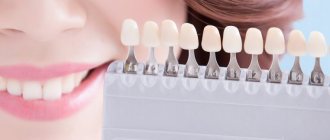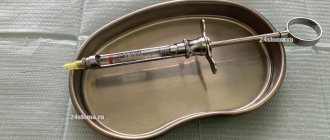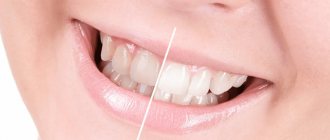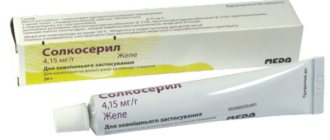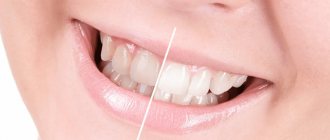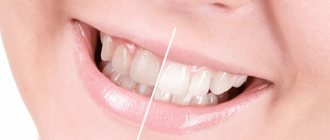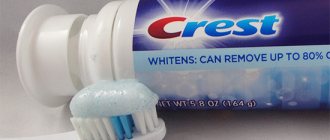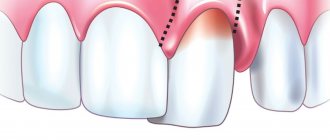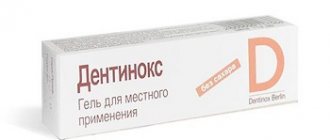1213
Devitalization in dentistry is the destruction (killing) of the pulp for the purpose of its subsequent painless removal.
The procedure is carried out using devitalization drugs that kill the nerve bundle of the pulp and cause the death of its tissue.
One of the drugs popular among dentists is Kaustinerv, which will be discussed further.
Indications and contraindications
Killing the pulp using devitalization pastes is used in cases where it is impossible to use injection or application methods of local anesthesia.
The following reasons may lead to such situations:
- hypersensitivity of the patient's body to anesthetics, in particular to lidocaine;
- insurmountable fear of the patient (usually children) to injections;
- the presence of severe systemic diseases;
- failures (insufficient pain relief) of the injection or application method.
General information
Devitalization in the dental field is the process of killing the pulp for its further removal without pain. The process is possible with the use of devitalization agents, which can kill the nerve processes of the pulp and cause the death of its tissues.
What does a tooth look like?
The surface of a healthy tooth is covered with white enamel, underneath is dentin. The inside of the tooth is made up of pulp with small blood vessels and nerves.
The number of large nerves directly depends on the structure of the root and the number of its processes. And the bundle of nerves in the pulp is formed by compact nerve fibers.
When the crown is destroyed down to the pulp, increased pain begins to appear.
Why is removal necessary?
It is possible to exclude nerve removal if therapy begins at the primary stage of dentin destruction. Pulpitis, which has passed into the periodontium, is a symbol of the transformation of the disease. Then the elimination of the nerve or pulp cannot be avoided.
Surgery is necessary when a tooth is deformed. Defragmentation is possible from caries or physical trauma.
Symptoms of inevitable depulpation:
- aching soreness that occurs for no reason and persists for a long time. Has no tendency to complacency.
- episodic pain. The reasons are a change in the level of humidity in the room, from cold or hot products, from eating a large amount of sweets. After eliminating the source of irritation, pain is still present.
- an unnatural dental arrangement determined from an anatomical point of view.
- inflammatory process in the pulp or the onset of periodontitis.
- mechanical trauma with damage to dentin.
Instructions for use
Devitalization is performed in the following sequence.
- A carious cavity is developed , and a recess is made at its bottom to place the paste at a minimum distance from the pulp.
- A small ball (about the size of a pinhead) is made from the paste and carefully, without pressure, placed into the hole.
- A temporary filling is placed on the tooth , and the patient is sent home. A repeat visit is scheduled after a few days, depending on the duration of action of the devitalization paste.
- At the next visit, the temporary filling is opened and removed along with the devitalizing drug. Under the influence of arsenic or paraformaldehyde, the pulp becomes fibrous and can be removed easily and painlessly.
Sometimes, due to severe pain, it is not possible to get close to the pulp. In this case, devitalization is performed in two steps.
After the first application of the medicine, due to a decrease in the sensitivity of dentin, it becomes possible to get closer to the pulp.
Next, endodontic treatment of the tooth is carried out according to the standard scheme:
- Access to the coronal cavity is created using burs , the affected tooth tissue is excised and removed.
- The tooth cavity is opened and the contents of the pulp chamber are removed.
- Root canals are treated. Mechanical treatment is combined with medication using antiseptic, degreasing and hydrating drugs.
- Obturation (filling) of the root canals is carried out with cement or composite material.
- Finally, the crown part of the tooth is formed , which, if necessary, can be covered with an artificial filling.
Details
Carrying out a procedure in dentistry
The dentist drills the canal and later injects medicine into it. The speed of the therapy period is directly dependent on the severity of the defect and personal indicators.
The most widespread are arsenic pastes.
Release form "Kaustinerv"
Rapid - thirty percent composition is arsenic anhydride, lidocaine, menthol, ephedrine, phenol are also included. Impact - thrombocytosis of blood vessels of the pulp - oxygen starvation and tissue death.
The dentist brings the medicine as close as possible to the area of devitalization. The result and speed of action of the product are directly dependent on the thickness of the dentin. The average is a couple or three days.
Forte - lidocaine, paraformaldehyde, phenol.
It is used for pulp extirpation without the use of arsenic. It works as an antiseptic and mummifier for pulp tissue, causing its necrosis. Arsenical – contains arsenic anhydride. The product is produced in plastic packaging, which is placed in a cardboard box with instructions for use. Impact - thrombocytosis of blood vessels of the pulp - oxygen starvation and tissue death.
Instructions
The doctor places a spherical piece of the product at the bottom of the cavity, eliminating pressure. The dental unit is sealed with a temporary filling. After seven to ten days, the cavity is opened (in the case of using arsenic Kaustinerv Rapid and Kaustinerv Arsenic - three days). The temporary filling is removed with the medicine. The pulp breaks down into fibers, making it easy to remove.
The dosage is always the same - the ball is no larger than a millimeter in size.
Allergy and irritation are possible in case of hypersensitivity to the ingredients of the material.
The use of paste implies a solid state; the cavity must be carefully covered with a temporary filling to prevent the process of evaporation of the active substance.
It is necessary to stop driving for a while.
Storage temperature is no more than twenty-five degrees Celsius. The lid is sealed tightly. After opening, the medicine can be stored for one year.
Dosage and precautions
When using all devitalization pastes, the same dosage is used - a tiny ball of paste the size of a pinhead (about 1 mm in diameter). The maximum permissible dose is 10 mg.
Since these are highly toxic drugs, the following precautions must be observed:
- It is necessary to prevent accidental swallowing of the paste.
- For a temporary filling, use cement of a weak consistency so that it can be opened without excessive force, which could cause the release of paraformaldehyde or arsenic.
- The temporary filling must be absolutely airtight. If arsenic or paraform comes into contact with the mucous membrane of the gum or cheek, irritation and necrosis may occur. If a leak does occur, the affected area should be rinsed quickly with water.
- The paste should not be left in the tooth for more than 7 days.
- The medicine ball should be placed in the place prepared for it without strong pressure.
Important! Devitalization drugs contain substances that can give a positive reaction in a doping test.
Contraindications for devitalization are:
- allergy to the ingredients of the devitalizing paste (most often the culprit is lidocaine);
- age up to 30 months;
- glaucoma;
- anuria.
General presentation and purpose
Kaustinerv paste is produced by the French pharmaceutical company in three varieties:
- Forte. This product contains phenol and lidocaine and is used to remove pulp if it is necessary to use arsenic-free formulations.
- Arsenical . This type contains arsenic; the paste is used for devitalization if there are no contraindications for the content of this component.
- Rapid. This is an arsenic variety with menthol, ephedrine and lidocaine.
The paste has an analgesic effect, is used for rapid extirpation of tooth pulp and promotes an antiseptic effect.
Storage conditions
Kaustinerv devitalizing pastes can be stored for up to six months at a temperature not exceeding 25 °C. The material in opened cans retains its performance properties for a year, provided the lid is tightly closed.
Additional conditions for use and storage of pastes are contained in the instructions.
The purpose of using arsenic in dentistry and analogue products.
In this publication we will talk about what a pediatric dentist surgeon does.
Here https://www.vash-dentist.ru/hirurgiya/rezektsiya/effektivnost-tsistektomii-zuba.html read about the indications and contraindications for dental cystectomy.
Composition and properties
The composition includes the following components:
- Lidocaine – up to 37%.
- Arsenic (only in two varieties - Rapid and Arsenical).
- Paraformaldehyde – up to 46%.
- Phenol.
The presence of paraformaldehyde in the composition promotes the coagulation of albumin, and lidocaine serves as the main anesthetic component and acts as a local anesthesia.
The impact of the paste leads to softening of the pulp and increased fibrousness, due to which rapid removal occurs.
Let's find out together why the tooth hurts after nerve removal and cleaning, and what can be done.
Come here if you are interested in how to kill the dental nerve.
At this address https://zubovv.ru/hirurgiya/udalenie-nerva/kak-ispolzuyut-myishyak-v-stomatologii.html we’ll talk about modern arsenic substitutes in dentistry.
Analogues and prices
The following preparations can be used as a replacement for Caustinerf pastes:
- Depulpin. Contains paraformaldehyde. When used, side effects are possible in the form of pain, which gradually subside under the influence of the lidocaine contained in the paste. Release form – 3 g of paste placed in a syringe.
- Devital. Arsenic-free preparation containing 30 percent paraform.
The advantages of Devital include the absence of arsenic, the ability to be used for children, and the relatively short time for complete devitalization, usually 3-5 days. But sometimes canal cleaning and final filling can be done within 1-2 days. Available in 5 and 13 g in plastic and glass bottles. - Devit S. Contains paraformaldehyde, as well as auxiliary materials - lidocaine, creosote, paste former with filler. The average time of devitalization is 3-5 days.
Prices for pastes vary significantly, and depend primarily on the brand.
Approximate prices for devitalizing pastes are shown in the table.
| Trademark | Manufacturer | Active substance | Quantity, g | Price, rub |
| Kaustinerv Fort | Septodont (France) | Paraformaldehyde | 4,5 | From 4000 |
| Kaustinerv Rapide | Same | Arsenic oxide | 5,5 | From 2600 |
| Kaustinerv Arsenical | Same | Arsenic oxide | 6,5 | From 4000 |
| Depulpin | Voco (Germany) | Paraformaldehyde | 3 | From 3100 |
| Devital | TechnoDent (Russia) | Paraformaldehyde | 5 and 13 | From 200 |
| Devit S | VladMiVa (Russia) | Paraformaldehyde | 3 | From 120 |
How to kill a nerve in a tooth at home?
Since it is unlikely that you will be able to kill the nerve in a tooth on your own, a visit to the dentist in case of prolonged acute or aching toothache is inevitable. But there are many ways to relieve pain for a while in order to calmly survive the holidays or weekends.
- The most popular folk remedy for dental problems is salt. 1 teaspoon dissolved in a glass of warm water is an excellent rinse for relieving an acute attack.
- Salt + garlic. Grind a clove of garlic with a small amount of salt and put the paste on the sore tooth - this is an excellent antimicrobial and analgesic. If the situation is aggravated by swelling of the gums, you can try rinsing with a decoction of garlic.
- Propolis. You can buy a ready-made tincture at a pharmacy or prepare it yourself. To do this, you need to take 30 grams of herb and pour 200 ml of alcohol into it, after 10 days of infusion in a dark, cool place, the medicine is ready. By moistening a cotton swab with the tincture and applying it to the tooth, you can relieve a painful attack.
- Comfrey. The principle is the same: dip a cotton swab in the root tincture and place it on the sore spot. It’s easy to prepare the shake: 10 grams of comfrey root + 50 ml of alcohol, let it brew for 10 days.
- 3% hydrogen peroxide. Dilute 2 to 1 with warm water, dip a cotton swab and place it on the exposed tooth.
- Onion peel. Pour a small handful of dry husks (15-20 grams) with half a liter of boiling water and bring to a boil over low heat. Strain the resulting broth, let it brew for a couple of hours, then you can rinse your mouth. This infusion calms the nerve, relieves pain and disinfects the oral cavity.
- Lilac. A decoction of the leaves of the bush is especially effective. It needs to be prepared in the same way as onion stew.
- Clove essential oil will soothe the affected nerve. You need to drop a little onto a cotton swab and cover the painful area with it.
- Herbal infusions. Chamomile, lemon balm, mint, thyme, sage or oak bark will be used. It is better to rinse your mouth with a warm broth, so as not to further irritate the affected nerve.
- In villages, wheat is often used to relieve toothache. If you have the juice of mature sprouts on hand, just drop a little at the epicenter of the pain.
Reviews
Have you ever had to undergo dental devitalization? If so, what agent was used to kill the pulp, and what sensations did you experience? Share with our site visitors by leaving your comment at the bottom of this page.
If you find an error, please select a piece of text and press Ctrl+Enter.
Tags medications pulpitis
Did you like the article? stay tuned
Previous article
How does Atatsamit cement work and in what cases is it used?
Next article
Profiles in dentistry - get right to the root
Drastic ways to kill the dental nerve
If rinses and lotions do not help, and the tooth does not allow you to live in peace, you can try to solve the problem in a more drastic way. There are quite a few myths about how to kill a nerve in a tooth at home. One of the most ridiculous is the use of gunpowder. First of all, where would he get a house from? And secondly, such amateur activity is fraught with sad consequences for the body. However, like putting arsenic in the hole of a tooth. This is a powerful poison that, even in tiny doses, can deprive a person of not only his nerve, but his life! It is important to understand that the pastes discussed above do not use arsenic itself in its pure form, but its salts in carefully adjusted proportions.
So how can you kill the nerve in a tooth if you can’t go to the dentist right now?
- Vinegar essence. Unlike gunpowder and arsenic, it is much easier to get. The manipulation is simple: moisten a small cotton swab with acid and place it in the hole of the tooth. You must first thoroughly disinfect your hands so as not to aggravate the situation by adding pathogenic microbes, and act carefully, as there is a high risk of burning your gums.
- Alcohol. If rinsing with alcohol tinctures does not help, you need to wet a piece of cotton wool with alcohol and place it at the epicenter of the pain, preferably directly into the carious hole.
- Zinc. Of course, it may not be at home in its pure form. But it is easy to obtain from ordinary printing ink. To do this, you can take any sheet of newspaper, but it is better if there are large black drawings on it, crumple it on a plate and burn it. Then, using a cotton swab moistened with your own saliva, quickly collect the ashes and place them in the tooth. The whole thing can be covered with another clean swab on top. Aldehydes and zinc contained in the ashes will kill the nerve. To prevent the procedure from being so painful, 15-20 minutes before, you can take a Ketanov tablet or another strong painkiller. The most effective medications for toothache are baralgin, novalgin, analgin, and pentalgin.
Whatever method of self-help you practice, the main thing to remember is that you still cannot do without the help of a dentist. Even if you managed to kill the nerve in the tooth at home, no later than two weeks later, you will still have to sit in the doctor’s chair so that he removes the dead tissue, cleans and seals the canals. Otherwise, a protracted inflammatory process cannot be avoided.
Sources used:
- Practical dentistry / I.K. Lutskaya. - M., 2000.
- Prevention of caries in the pits and fissures of teeth / T.V. Popruzhenko. - M.: MEDpress-inform, 2010.
- Practical therapeutic dentistry" (Nikolaev A.)
- Therapeutic dentistry, E. V. Borovsky et al., Moscow., 1998
- Dr. Mercola. Why Don't You Try This?: 97% of Terminal Cancer Patients Previously Had This Dental Procedure
